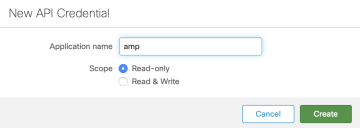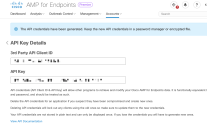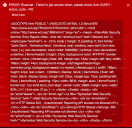Configuring Cisco AMP Connectors
Connectors allow Stellar Cyber to collect data from external sources and add it to the data lake.
A Cisco Advanced Malware Protection (AMP) connector allows you to collect logs, discover assets, and see vulnerabilities. There can be any number of Cisco AMP connectors active.
Connector Overview: Cisco AMP
Capabilities
-
Collect: Yes
-
Respond: No
-
Native Alerts Mapped: No
-
Runs on: DP
-
Interval: Configurable
Collected Data
|
Content Type |
Index |
Locating Records |
|---|---|---|
|
Computers Events Vulnerabilities |
Syslog Assets Linux |
Domain
|
<Host URL> where <Host URL> is a variable from the configuration of this connector |
Response Actions
N/A
Third Party Native Alert Integration Details
N/A
Required Credentials
-
Client ID and API Key
Let us know if you find the above overview useful.
Adding a Cisco AMP Connector
To add a Cisco AMP connector:
- Create Cisco AMP API credentials
- Add the connector in Stellar Cyber
- Test the connector
- Verify ingestion
Creating Cisco AMP API Credentials
To create Cisco AMP API credentials:
Use our example as a guideline, as you might be using a different software version.
- Log in to your Cisco AMP dashboard at https://console.amp.cisco.com .
-
Click Accounts | API Credentials.
The API Credentials page appears.
-
Click New API Credential. The New API Credential screen appears.
- Enter an Application name.
- Choose Read-only for the Scope.
-
Click Create. The API credentials are immediately generated and the API Key Details page appears.
- Copy the 3rd Party API Client ID and API Key. You will need these when adding the connector in Stellar Cyber.
Adding the Connector in Stellar Cyber
With the client ID and API key handy, you can add the Cisco AMP connector in Stellar Cyber:
-
Log in to Stellar Cyber.
-
Click System | Integration | Connectors. The Connector Overview appears.
-
Click Create. The General tab of the Add Connector screen appears. The information on this tab cannot be changed after you add the connector.
The asterisk (*) indicates a required field.
-
Choose Endpoint Security from the Category drop-down.
-
Choose Cisco AMP from the Type drop-down.
-
For this connector, the supported Function is Collect, which is enabled already.
-
Enter a Name.
This field does not accept multibyte characters.
-
Choose a Tenant Name. The Interflow records created by this connector include this tenant name.
-
Choose the device on which to run the connector.
-
(Optional) When the Function is Collect, you can create Log Filters. For information, see Managing Log Filters.

-
Click Next. The Configuration tab appears.
The asterisk (*) indicates a required field.
-
Enter the Host URL. Use the Cisco AMP for Endpoints API host (https://api.amp.cisco.com), not the Console Management URL.
-
Enter the Client ID. This is the 3rd Party API Client ID you copied earlier.
-
Enter the API Key. This is the API Key you copied earlier.
-
Choose the Interval (min). This is how often the logs are collected.
-
Choose the Content Type you would like to collect. The logs for Computers, Events, and Vulnerabilities are supported.
-
Click Next. The final confirmation tab appears.
-
Click Submit.
To pull data, a connector must be added to a Data Analyzer profile if it is running on the Data Processor.
The new connector is immediately active.
Testing the Connector
When you add (or edit) a connector, we recommend that you run a test to validate the connectivity parameters you entered. (The test validates only the authentication / connectivity; it does not validate data flow).
For connectors running on a sensor, Stellar Cyber recommends that you allow 30-60 seconds for new or modified configuration details to be propagated to the sensor before performing a test.
-
Click System | Integrations | Connectors. The Connector Overview appears.
-
Locate the connector that you added, or modified, or that you want to test.
-
Click Test at the right side of that row. The test runs immediately.
Note that you may run only one test at a time.
Stellar Cyber conducts a basic connectivity test for the connector and reports a success or failure result. A successful test indicates that you entered all of the connector information correctly.
To aid troubleshooting your connector, the dialog remains open until you explicitly close it by using the X button. If the test fails, you can select the button from the same row to review and correct issues.
The connector status is updated every five (5) minutes. A successful test clears the connector status, but if issues persist, the status reverts to failed after a minute.
Repeat the test as needed.
Verifying Ingestion
To verify ingestion:
- Click Investigate | Threat Hunting. The Interflow Search tab appears.
- Change the Indices to Syslog if you chose the Events content type. The table immediately updates to show ingested Interflow records.
- Change the Indices to Assets if you chose the Computers content type. The table immediately updates to show ingested Interflow records. Also, hosts discovered through this connector show Cisco AMP as a data source.
- Change the Indices to Linux Events if you chose the Vulnerabilities content type. The table immediately updates to show ingested Interflow records.












